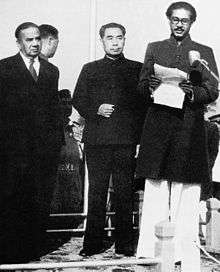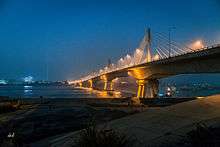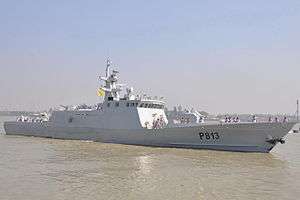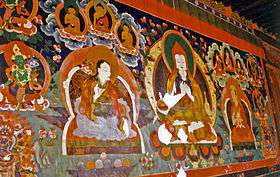Bangladesh–China relations
Bangladesh–China relations are the bilateral relations of Bangladesh and China. Bangladesh has an embassy in Beijing and consulates in Hong Kong and Kunming. China has an embassy in Dhaka. Both countries are members of the BCIM Forum (Bangladesh-China-India-Myanmar Forum for Regional Cooperation). According to Chinese government designations, Bangladesh and China are "strategic partnership of cooperation".[1]
 | |
China |
Bangladesh |
|---|---|
Country comparison
| Area | 147,570 km2 | 9,596,961 km2 |
| Population | 162,950,000 | 1,376,049,000 |
| Population density | 1,106/km2 | 145/km2 |
| Capital | Dhaka | Beijing |
| Largest Metropolitan Areas | Dhaka | Shanghai |
| Government | Parliamentary democracy with Islam as state religion | Communist unitary one party state |
| First leader | Sheikh Mujibur Rahman | Mao Zedong |
| Current leader | Sheikh Hasina | Xi Jinping |
| Official languages | Bengali | Chinese |
| GDP (nominal) | $314.656 billion | $14.216 trillion |
| GDP (nominal) per capita (2019) | US$1,888 | US$10,153 |
| GDP (PPP) (2019) | US$831.750 billion | US$27.331 trillion |
| GDP (PPP) per capita (2019) | US$4,992 | US$19,520 |
| Human Development Index | 0.608 (medium) | 0.752 (high) |
| Foreign exchange reserves | 33,100 (millions of USD) | 4,009,553 (millions of USD) |
| Military expenditures | US$3.03 billion (1.2% of GDP) | US$166.107 billion (2012) (2.0% of GDP) |
| Manpower | Active troops: 157,000 (63,000 reserve personnel) | Active troops: approximately 2,285,000 (800,000 reserve personnel) |
| Main religions | Islam (90%), Hinduism (9.5%), Buddhism (0.6%), Christianity (0.4) and others (1%). | 10% each: non-religious, folk religions and Taoism, Buddhism. Minorities religions are Islam and Christianity |
History


Bengal and Imperial China
Chinese monks, scholars and traders began frequenting Bengal (Tosali Province) from the Qin dynasty period. Famous ancient Chinese travelers to Bengal included Faxian, Yijing and Xuanzang.[2] During the Pala Empire of Bengal, Atisa of Bikrampur traveled to Tibet and played an important role in developing Tibetan Buddhism.[2]
In 648, a companion of the Prophet Muhammad, Sa'd ibn Abi Waqqas, who is credited have introduced Islam in China, is said to have followed a route via the Brahmaputra. Evidence remains in Lalmonirhat of a masjid built by himself and is known locally as Abi Waqqas Masjid.[3][4]
Political relations became nonexistent after the decline of Buddhism.[5] After the Muslim conquest of Bengal in the 13th century, general Bakhtiar Khilji attempted to invade Tibet, which was a protectorate of China.[6] Khilji's army was compelled to retreat due to the harsh conditions of the Himalayas. Ming China and the Bengal Sultanate exchanged many embassies during the 15th century. Sultan Ghiyasuddin Azam Shah began sending envoys to the Ming dynasty. He sent ambassadors in 1405, 1408 and 1409.[7] Emperor Yongle of China responded by sending ambassadors to Bengal between 1405 and 1433, including members of the Treasure voyages fleet led by Admiral Zheng He.[8] The exchange of embassies included the gift of an East African giraffe by Sultan Shihabuddin Bayazid Shah to the Chinese emperor in 1414 after the Chinese envoys noticed Bengal's trade with Malindi.[8][9][10][11] The Treasure voyages led by the Chinese Muslim admiral Zheng He visited the Bengal Sultanate several times. Ming China, under the Yongle Emperor, also mediated in the Bengal Sultanate-Jaunpur Sultanate War creating peace between the two countries.[2][12]
Experts have also speculated on the possibility of a southwestern Silk Road connecting Bengal and China.[13]
East Pakistan
Chinese premier Zhou Enlai visited East Pakistan several times in the 1950s and 60s. The Chinese Communist Party maintained close ties with Bengali nationalist leaders Maulana Abdul Hamid Khan Bhashani and Huseyn Shaheed Suhrawardy. Bhashani in particular, was considered close to Mao Zedong. While serving as the Prime Minister of Pakistan in 1957, Awami League president H. S. Suhrawardy became the first Pakistani leader to make a state visit to the PRC.
Sectoral relations
Geopolitical relations
When the Bangladesh War of Independence broke out in 1971, complex geopolitical rivalries erupted in South Asia. The Bangladeshis elicited the help of India in their freedom struggle. China had earlier fought a war with India in 1962 and became an ally of Pakistan. Crucially, it was using Pakistan as a conduit for rapprochement with Richard Nixon and Henry Kissinger in the United States. The PRC also replaced Taiwan (Republic of China) as a permanent member of UN Security Council in 1971. Its first veto was used to support Pakistan during the Indo-Pakistani War of 1971. In the early years of Bangladesh's independence, Dhaka was also close to the Soviet Union, which was a rival of China following the Sino-Soviet split. Despite the support of most countries in the world, Bangladesh's UN membership was vetoed by China until 1974. The situation dramatically changed after military coups in Bangladesh began in 1975, causing Bangladesh to distance itself from the Indo-Soviet Cold War axis in South Asia. China and Bangladesh established diplomatic relations in January 1976.[14] The period coincided with the recognition of the PRC as the sole legitimate government of China by most of the world. The period also saw the Chinese begin to embrace market socialism. President Ziaur Rahman, who restored free markets in Bangladesh, visited Beijing and the laid the groundwork for the relationship; while numerous Chinese leaders visited Dhaka in the late 1970s.

By the mid-1980s, China had forged close military, commercial and cultural ties with Bangladesh and also supplied it with military aid and equipment.[14] The then-president of Bangladesh Hossain Mohammad Ershad was warmly received in Beijing in July 1987. A Bangladesh-China friendship bridge was constructed and inaugurated over river Buriganga connecting Dhaka and Munshiganj by the Chinese as a token of this newly advancing diplomatic and military relationship. On 4 October 2000, the Government of Bangladesh issued a postal stamp marking the 25th anniversary of the establishment of Bangladesh-China diplomatic relations. By this time, China had provided economic assistance totaling US$300 million to Bangladesh and the bilateral trade had reached a value mounting to a billion dollars.[15] In 2002, the Chinese Premier Wen Jiabao made an official visit to Bangladesh and both countries declared 2005 as the "Bangladesh-China Friendship Year."[16]
The two countries signed nine different bilateral agreements to further their mutual relationship.[17]
On Bangladesh Nationalist Party PM Begum Khaleda Zia's invitation China was added as an observer in the South Asian Association for Regional Cooperation (SAARC).[18] After Cyclone Sidr hit Bangladesh in 2007, China donated US$1 million for relief and reconstruction in cyclone-hit areas.[19]
Tibet issue
The Chinese embassy in Bangladesh has twice intervened during local art shows to censor coverage of the plight of Tibetan refugees in South Asia. In 2009, police canceled a planned photo exhibit on Tibetan exiles at the Drik gallery in Dhaka, after requests from the Chinese embassy.[20] In 2016, the Chinese ambassador protested against Tibetan exhibits at the Dhaka Art Summit, which led the organizers to censor coverage of Tibet.[21]
Economic relations


Bangladesh-China bilateral trade is highly tilted in favour of Beijing,[22][23][24] and Bangladesh's bilateral trade deficit with China has increased 1600 % in last 20 years (c. 2019).[22] 25% of Bangladesh's total imports are from China, in 2018-19 China's export to Bangladesh was US$13.6 million whereas Bangladesh’s export to China was only $0.56 billion.[22] China has given several loans to Bangladesh, which compared to India [with which Bangladesh shares land border on 3 sides] are on less favorable terms, and could lead Bangladesh into debt-trap.[22] China has also offered to construct nuclear power plants in Bangladesh to help meet the country's growing energy needs, while also seeking to aid the development of Bangladesh's natural gas resources.[25] [26] China's mainly imports raw materials from Bangladesh like leather, cotton textiles, fish, etc. China's major exports to Bangladesh include textiles, machinery and electronic products, cement, fertiliser, tyre, raw silk, maize, etc.[27]
In 2005, Chinese premier Wen Jiabao visited Bangladesh on an official visit on 7 and 8 April. Various agreements were signed during this visit. On transportation side, China and Bangladesh have agreed to start a direct air transport route between Dhaka and Beijing via Kunming. Also Kunming-Chittagong road link through Myanmar is also considered.[23] The Chinese premier readily agreed to constructing the Di-Aluminium Phosphate (DAP) fertiliser factory in Chittagong entirely on concessional lending instead of on supplier's credit.[28] In 2007, Chinese Assistant Minister of Commerce, Wang Chao visited Bangladesh with the 39-member purchase delegation. It is the biggest purchase delegation ever to Bangladesh with over 10 companies listed in China's top 500 and some of them in world's top 500. Delegation is reported to have purchased Bangladeshi goods worth over US$50 million.[29] Both countries accepted to build a "Bangladesh-China Friendship Exhibition Center" in Dhaka.[29]the amount of foreign trade between Bangladesh and China is about 10 billion dollars. Bangladesh import about 8 billion dollars of goods from China while it exports 2 billion dollar of good. However, China has recently waived tariffs of 97% Bangladesh's products. This will reduce the trade deficit between Bangladesh and China.
Defense cooperation
The Bangladesh Army has been equipped with Chinese tanks, its navy has Chinese frigates and missile boats and the Bangladesh Air Force flies Chinese fighter jets. In 2002, China and Bangladesh signed a "Defence Cooperation Agreement" which covers military training and defence production. In 2006, a Chinese report to the United Nations revealed that Dhaka is emerging as a major buyer of Chinese-made weapons. China sold 65 large calibre artillery systems, 16 combat aircraft and 114 missile and related equipment to Bangladesh in 2006. Bangladesh also bought roughly 200 small arms and regular artillery pieces from China.[30]
In 2008, Bangladesh set up an anti-ship missile launch pad near the Chittagong Port with assistance from China. The maiden missile test was performed on 12 May 2008 with active participation of Chinese experts. It successfully test-fired anti-ship missile C-802A with a strike range of 120 km from the frigate BNS Osman near Kutubdia Island in the Bay of Bengal. BNS Osman which was commissioned in 1989, is a 1500-ton Chinese built Jianghu class Frigate, and the C-802A missile is a modified version of Chinese Ying Ji-802 with weight reduced from 815 kg to 715 kg to increase the strike range from 42 km to 120 km.
Bangladesh's regional neighbors Myanmar, Thailand, Pakistan and Sri Lanka also depend on Chinese military supplies; as do other Muslim-majority countries of similar size, including Egypt, Nigeria and Sudan.
 A Chinese built patrol ship of the Bangladesh Navy
A Chinese built patrol ship of the Bangladesh Navy.jpg)
 Chinese Type 69 tanks of the Bangladesh Army
Chinese Type 69 tanks of the Bangladesh Army
Water security: River water sharing
Bangladesh and India have signaled concerns over Chinese plans to dam and divert water from the Brahmaputra River in Tibet.[31]
Diaspora
There is a sizeable Chinese diaspora in the Bangladeshi capital, Dhaka; first arriving in the 1940s and a smaller population in Chittagong. Their presence is seen as a result of the First World War. Many tend to work as shoemakers or are involved in the opium trade, while others have opened up many Chinese restaurants across the country with its own Bangladeshi twist.[32] Many popular beauty parlours are also run by Chinese Bangladeshis.[33] Areas densely populated with Chinese people in Dhaka include Imamganj and Mitford.[34]
See also
Bibliography
- Cardenal, Juan Pablo; Araújo, Heriberto (2011). La silenciosa conquista china (in Spanish). Barcelona: Crítica. p. 257. ISBN 9788498922578.
References
- Meng, jie (8 March 2018). "Bangladeshi president hopes for new high in Bangladesh-China ties". Xinhua.
- Ministry of Foreign Affairs of the People's Republic of China
- Mahmood, Kajal Iftikhar Rashid (19 October 2012). সাড়ে তেরো শ বছর আগের মসজিদ [1350 Year-old Mosque]. Prothom Alo (in Bengali).
- "History and archaeology: Bangladesh's most undervalued assets?". deutschenews24.de. 21 December 2012. Archived from the original on 15 March 2014. Retrieved 12 June 2014.
- India and China: Interactions through Buddhism and Diplomacy: A Collection of Essays by Professor Prabodh Chandra Bagchi. Anthem Press. 1 October 2011. p. 109. ISBN 978-0-85728-821-9. Archived from the original on 15 May 2018.
- Farooqui Salma Ahmed (2011). A Comprehensive History of Medieval India: Twelfth to the Mid-Eighteenth Century. Pearson Education India. pp. 53–. ISBN 978-81-317-3202-1.
- "Ghiyasuddin Azam Shah - Banglapedia". en.banglapedia.org. Archived from the original on 3 July 2015.
- Church, Sally K. (2016). "The Giraffe of Bengal: A Medieval Encounter in Ming China". The Medieval History Journal. 7: 1–37. doi:10.1177/097194580400700101.
- N. W. Sobania (2003). Culture and Customs of Kenya. Greenwood Publishing Group. p. 14. ISBN 978-0-313-31486-5.
- Lin Ma; Jaap van Brakel (25 March 2016). Fundamentals of Comparative and Intercultural Philosophy. SUNY Press. p. 135. ISBN 978-1-4384-6017-8.
- Giorgio Riello; Zoltán Biedermann; Anne Gerritsen (28 December 2017). Global Gifts: The Material Culture of Diplomacy in Early Modern Eurasia. Cambridge University Press. p. 18. ISBN 978-1-108-41550-7. Archived from the original on 15 May 2018.
- The Bengali envoy....complained at the Ming court. In the 9th moon, the Ming ... The "Zhaonapuer"Jaunpur troops withdrew from Bengal. (Here is a unique episode of China's mediating in the conflict between two Indian states.Chung Tan; Yinzeng Geng (2005). India and China: twenty centuries of civilization interaction and vibrations. Project of History of Indian Science, Philosophy and Culture, Centre for Studies in Civilizations. p. 361. ISBN 978-81-87586-21-0.
- "Between Winds and Clouds: Chapter 2" (PDF). Retrieved 26 December 2019.
- "Bangladesh - China and Other Asian Nations". countrystudies.us.
- "Dhaka Issues Memorial Stamps on Bangladesh-China Diplomatic Relationship". People's Daily. 4 October 2000. Retrieved 15 September 2008.
- Habib, Haroon (9 April 2005). "Bangladesh, China sign nine agreements" – via www.thehindu.com.
- Habib, Haroon (9 April 2005). "Bangladesh, China sign nine agreements". The Hindu. Archived from the original on 24 September 2008. Retrieved 15 September 2008.
- "China pledges to further promote China-Bangladesh ties". Xinhua News Agency. 7 June 2006. Retrieved 15 September 2008.
- "China donates US$1 mln to Bangladesh". CCTV. 21 November 2007. Retrieved 15 September 2008.
- "Police prevent Tibet photo exhibition".
- "Dhaka art summit: Tibetan exhibit covered up after China 'protest'". 8 February 2016.
- India plans to enhance trade with Bangladesh, Economic Times, July 2020.
- Kumar, Anand (21 April 2005). "Changing Dynamics of Sino-Bangladesh Relations". southasiaanalysis group. Archived from the original on 13 June 2010. Retrieved 15 September 2008.
- "China grants over USD 10 mn aid to Bangladesh". 23 July 2007 – via The Economic Times.
- "China's March on South Asia". Archived from the original on 16 April 2014.
- "China keen to build Rooppur nuclear plant". Archived from the original on 16 April 2014. Retrieved 24 May 2008.
- "China and Bangladesh". The Department of Asian Affairs, People's Republic of China. 25 August 2003. Retrieved 18 January 2010.
- Mohammad Mahabubur Rahman, Dr. Kazi Ihtesham (23 May 2005). "Sino-Bangla relations and Bangladesh's Look East policy". The Daily Star. Retrieved 15 September 2008.
- "China, Bangladesh to improve bilateral ties". The Hindu. Xinhua. 24 July 2007. Archived from the original on 3 November 2012. Retrieved 15 September 2008.
- Samanta, Pranab Dhal (9 September 2007). "Breaking 10-year silence, China reveals it's now No 1 arms supplier to Bangladesh". The Indian Express. Retrieved 15 September 2008.
- Bagchi, Indrani (12 June 2007). "Water-sharing clouds Indo-China ties". The Times of India. Retrieved 15 September 2008.
- McAdam, Marika (2004). Bangladesh. Lonely Planet. pp. 38–. ISBN 978-1-74059-280-2.
- "Beauties at the city's beauty shops". The Daily Star.
- Haraprasad Ray (2012). "The Chinese". In Sirajul Islam and Ahmed A. Jamal (ed.). Banglapedia: National Encyclopedia of Bangladesh (Second ed.). Asiatic Society of Bangladesh.
Further reading
| Library resources about Bangladesh–China relations |
- Church, Sally K. (2004). "The Giraffe of Bengal: A Medieval Encounter in Ming China". The Medieval History Journal. 7 (1): 1–37. doi:10.1177/097194580400700101.


.svg.png)